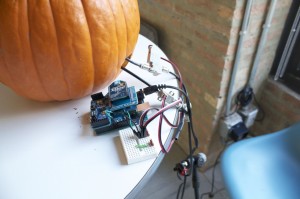 The people at IDEO hosted a pumpkin carving contest and one employee decided to build an iPhone app that controls the pumpkins eyes in just one hour.
The people at IDEO hosted a pumpkin carving contest and one employee decided to build an iPhone app that controls the pumpkins eyes in just one hour.
“I was able to conceptualize, build, and program this wirelessly-controlled-pneumatic-eye-popping pumpkin in just over an hour, barely missing the deadline but experiencing how powerful these low fidelity prototyping tools could be.”–source
Leading the change you want to see happen can often feel impossible and slow as your coordinate, motivate, and align people to the future. I love the idea of building prototypes/models that demonstrate concepts in “low fidelity,” since they help others see the vision that I have in my head.
Since ministries and non-profits often seek intangible outcomes (such as changed lives) prototyping can seem like a stretch. But the biggest changes these organizations need to make are structural–redesigning and tweaking their allocation of resources to match both the needs of the present and future.
Prototyping a new model can be an extremely effective way to lead change. Sometimes you can even test a structural change with a small segment. Before changing how you structure all your bible studies, why not experiment with one for a few weeks, gather feedback, and compare it to the existing structure?
The Power of One Hour
One hour might not be realistic for you but what about one week to make a change and measure the results? It’s easy to extend decisions well past the point of effectiveness, for the sake of engaging as many people as possible into the process. With smaller prototypes/experiments there are opportunities to involve less people, demonstrate results, and then take those results in addition to the concept to a larger group of people.
Enjoy the video!
